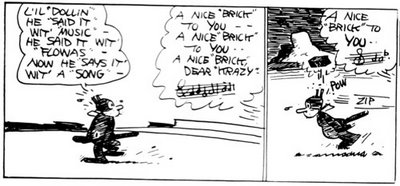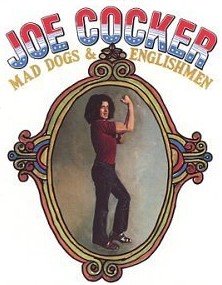I was born into the target audience for rock 'n' roll: Bill Haley in Grade 1, Beatlemania as I turned thirteen, and soul, folk-rock and psychedelia by the end of high school.
In my 30s, though, I went for months when I listened to almost nothing but the music of the 1930s, bookended by a little late 20s and early 40s.
I was mainly drawn to the swinging big bands, the golden age songwriters, and the sweet British dancebands (sweet isn't my word: it names a genre). I knew when I'd wandered too far into maudlin 40s dancehall ballads or cheesy novelties from the 20s.
My pathway was through the ABC's Saturday evening radio show Sentimental Journey. I used to hear some of it when I left the station on after the 7 o'clock News. I ended up staying for its full two hours every week.
I could not miss one episode, and I recorded many of them on C90 cassette. One Saturday after the News, the ABC neglected to switch its regional network across to the city network that carried Sentimental Journey. I phoned the ABC in Brisbane and was put through to a sceptical technical chap who finally took a look and fixed it.---
 |
| ABC Radio 1984 [link] |
The title Sentimental Journey was from the song of that name, first recorded by Doris Day with the orchestra of co-writer Les Brown in 1945. It suggests that the program was aimed at my parents' generation for whom returning to the music of the 30s and 40s might indeed have been a sentimental journey.
But that was the only hint in that direction. As I recall, the word nostalgia or notions of reliving the good old days were rarely, if ever, mentioned (although nostalgia was in presenter John West's own vocabulary). There were no cliches like What you were doing when you first heard this? or Ah the days when you could get an ice cream cone for a halfpenny! Certainly nothing like They don’t write songs like that any more.
In fact, this was its strength. There was this unspoken integrity about treating the music with respect, and allowing it to stand on its own merits, always.
The enthusiasm was for the music and its creators, not for its association with anyone’s golden memories. That was left to the listener to fill in for themself. Or not, as in my case.
For a newcomer like me, this was perfect. Because there was no assumption that the listener was here to relive the past, I was able to experience the music directly, without feeling I was eavesdropping on the reminiscences of another generation.If at first some of the arrangements and productions sounded old-fashioned, the more I immersed myself in the era the more it felt like familiar territory, free of any superficial cultural associations.
As a primary schoolteacher I used to run a lunchtime movie club where I played black and white silent-era comedies to 8- to 10-year-old film buffs. At the first session I told them these would be unlike other films they’d seen, and I had them mime putting on their "old-time movie glasses", like putting on sunglasses for the beach.
At first it was like that with me and 1930s music. It wasn’t exactly the same as listening to any genre that was familiar to me: I was adjusting my ears by putting on an imaginary pair of custom-made 1930s headphones.
---
 |
| John West 1989 [link] |
Also presenting segments were collectors or aficionados of old records, notably Graham Evans whom I remembered from Melbourne commercial station 3AW. Other features would appear, including a fine series of reminiscences by golden age songwriter Sammy Cahn. (His recurring phrase the phone rang inspired my website’s catchphrase eventually, someone emails.)
---
This affinity with old-time records didn’t come completely out of nowhere. I had been softened up by hearing the Red Onion Jazz Band a few times at Melbourne University from 1969. They played good-humoured trad jazz at its joyous best. When I sought out a song they played, Diga Diga Doo, I found it on Flaming Youth, a renowned album of Duke Ellington tracks from the 1920s that I ended up playing as often as any other LP I owned.My parents bought a lot of LP records in the 1950s, so they would have been able to hunt down reissues of music from their teens and twenties. But the only authentic pre-war music I ever heard in our house was on an LP released in the wake of the film The Glenn Miller Story (1954). Mum and Dad were early adopters of stereophonic sound, so when the old songs turned up they were often in orchestral versions that exploited stereo to full effect (Clebanoff, Mantovani), and sometimes by other recyclers of old tunes such as Ray Conniff And His Singers or Mitch Miller And The Gang. I'm assuming that for my parents, and many others, a return to the authentic music of their teenage years - the years of Depression and the outbreak of war - did not offer a sentimental journey.
This meant that I heard a lot of music during my school years, but not much from the pre-war years. By the early 80s my whole collection of 20s-30s-40s music had been Ellington's Flaming Youth and one album each by Fats Waller, Django Reinhardt, and Count Basie. Oh, and one outlier by British comic actor and talented ukulele player George Formby, known to me from TV reruns of his old films from the 30s. (I recently rewatched his 1935 film No Limit to groans from the other half of the household.)When I discovered Sentimental Journey in the 1980s it was a good time to be buying good quality reissues of records from the era of 78 rpm discs.
I bought an audiocassette of The Songs & Stars Of The Thirties (1980) an anthology that covered similar territory to Sentimental Journey, including vocalist Sam Browne's stirring version of Irving Berlin's Let's Face The Music And Dance. A World Record Club double LP set The Great British Dance Bands Play Jerome Kern 1926-46 (1983) had 38 Kern compositions including the excellent Denny Dennis singing The Folks Who Live On The Hill, a definitive version with Roy Fox And His Orchestra. Those two fine and prolific vocalists, Browne and Dennis, were previously unknown to me and probably familiar only to the aficionados these days. The ABC itself put out some fine series of albums curated by Robert Parker including Jazz Classics in Digital Stereo (from 1984) and The Golden Years in Digital Stereo (from 1986): nicely restored 78s with just a touch of stereo.In Dennis Potter's TV musical series Pennies From Heaven (1978-79) the characters frequently mimed lesser-known British songs from the 30s. Although Potter seemed to me to be taking the mickey a bit, the collections of songs that spun off from the series bore names that I'd never heard of until Sentimental Journey but were now familiar: Carroll Gibbons And The Savoy Hotel Orpheans, singers Denny Dennis and Elsie Carlisle, and orchestra leaders Roy Fox, Bert Ambrose, Lew Stone, and Jack Hylton. And yes, the ubiquitous Al Bowlly with Ray Noble And His Orchestra.
Since Pennies From Heaven, Al Bowlly has become something of a go-to voice of the 1930s for filmmakers. For example, Stanley Kubrick's The Shining and French favourite Amélie (2001) each used two Bowlly tracks, and another one appears in Withnail And I (1987). The Internet Movie Database lists over 40 films and TV series that have used Bowlly's records on their soundtracks since 1980.
---
As a child of Buddy Holly, Beatles and (to keep up the alliteration) Big Brother & the Holding Company, I was surprised to see how deeply I had become immersed in the works of Al Bowlly, Benny Goodman and Billie Holliday.
When you think about it, though, it is not impossible to find links between pre-rock 'n' roll music and post-Beatles pop. For a start, we had the ironic approximations of old music by the likes of The New Vaudeville Band (Winchester Cathedral) and even The Beatles (Honey Pie, Your Mother Should Know). More than that, as Keith Glass tells it in a Melbourne context, the beat and r&b bands of the 1960s were often formed by folk, skiffle and jazz musicians who adapted to the British Invasion sounds.
Indeed, three former members of the Red Onion Jazz Band, including vocalist Gerry Humphreys, formed Melbourne's Loved Ones, a critically and commercially successful r&b-oriented pop-rock band far removed from the sound - and visuals - of the Red Onions.
Far removed except for one thing: strong foot-tapping rhythm was a feature of popular music in both the 60s and the 30s. Anyone from my generation who thought the music of the old days was all slow, syrupy ballads got it badly wrong.
Further reading: My post about the rhythmic 1930s "Jazzing It Down"
See also: 1. "The ABC of West's Journey", The Age, 1 July 1989, on John West's retirement. 2. Posts at this blog labelled 30s music, 20s music, 40s music.
Spotify playlist (𝟑𝟑 tracks):
Sam Browne And The Rhythm Sisters - Let's Face The Music And Dance (1936)
Les Brown And His Orchestra, Vocal Chorus by Doris Day - Sentimental Journey (1945)
Joe Loss And His Band (Vocalist: Chick Henderson) - Begin The Beguine (1939)
Duke Ellington - Diga Diga Doo (1928)
Lew Stone And His Band - P.S. I Love You (1934)

























